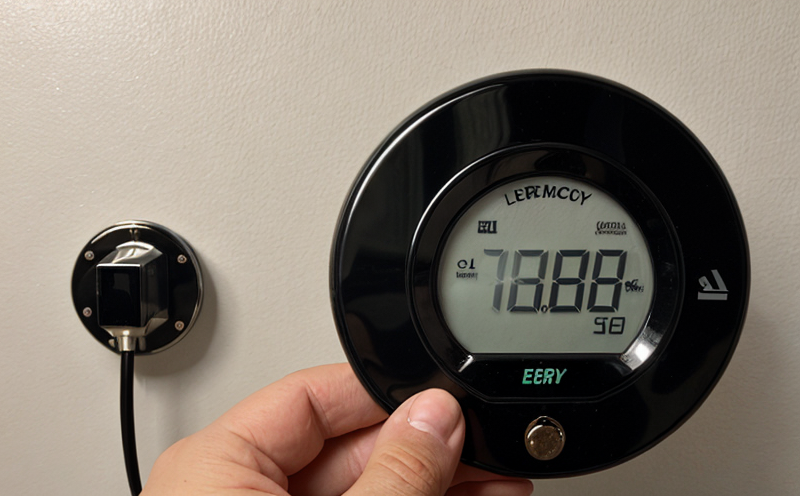DIN 18599 Energy Performance Testing for Buildings
The DIN 18599 standard is a crucial document in Germany that provides guidelines and procedures for the energy performance testing of buildings. This service focuses on ensuring that the energy efficiency and consumption levels of buildings are accurately assessed according to this standard.
Energy performance testing, as defined by DIN 18599, involves a comprehensive evaluation process aimed at quantifying the energy requirements of various building components. This includes heating systems, ventilation units, lighting installations, and insulation materials. The primary goal is to identify areas where improvements can be made to enhance thermal comfort while reducing overall energy consumption.
The testing procedure outlined in DIN 18599 involves multiple stages that ensure a thorough examination of the building’s envelope and internal systems. Initially, an assessment is conducted on-site using non-invasive methods such as thermographic imaging and airflow measurements. These initial evaluations help pinpoint potential hotspots or cold areas within the structure.
Once identified, more detailed inspections are carried out to gather data necessary for calculating energy consumption based on actual usage patterns. This may involve installing temporary monitoring equipment inside key rooms of the building over extended periods. During this time, various parameters including temperature variations, humidity levels, and power draw from electrical devices will be recorded.
After collecting all required information, a detailed report is generated summarizing findings along with recommended actions to address deficiencies found during testing. Compliance officers responsible for maintaining energy efficiency standards across organizations often rely heavily upon these reports when planning upgrades or renovations aimed at achieving better performance ratings according to DIN 18599.
Quality managers and R&D engineers play pivotal roles in ensuring adherence to this standard by incorporating its principles into product development cycles. By integrating energy efficiency considerations early on, manufacturers can design products that meet stringent requirements set forth by DIN 18599 while also contributing positively towards sustainability goals.
For procurement teams involved in sourcing materials used for constructing new buildings or retrofitting existing ones, understanding the criteria stipulated under DIN 18599 becomes essential. They must ensure that suppliers provide products meeting these stringent specifications so as not only to comply with regulatory mandates but also contribute towards creating healthier living environments.
In summary, DIN 18599 energy performance testing for buildings serves as a vital tool in assessing and optimizing the energy consumption levels of structures. Through rigorous on-site inspections followed by detailed analysis, this service helps stakeholders identify areas requiring improvement, thereby contributing significantly towards achieving sustainable development objectives.
- Thermographic imaging
- Airflow measurement
- Installation of temporary monitoring equipment
- Data collection on temperature variations, humidity levels, and power draw from electrical devices
Why It Matters
Understanding the importance behind conducting energy performance testing according to DIN 18599 cannot be overstated. For quality managers striving to maintain high standards within their organizations, compliance with this standard ensures that buildings are not only functional but also environmentally responsible.
Compliance officers play a crucial role in ensuring regulatory adherence and can leverage the insights gained from such tests to implement effective strategies aimed at reducing operational costs associated with heating, cooling, and lighting. Moreover, R&D engineers benefit greatly from this information as they gain valuable feedback on current designs which can then be refined for future iterations.
From an economic perspective, achieving better performance ratings according to DIN 18599 translates directly into lower utility bills for occupants of the building. Additionally, there is an increasing demand among consumers for green buildings that meet or exceed certain sustainability benchmarks. By participating in testing processes aligned with this standard, developers and owners can cater more effectively to these demands.
The broader societal impact extends beyond individual properties; it contributes positively towards efforts aimed at mitigating climate change impacts by promoting efficient use of resources. As global temperatures continue rising due to increased greenhouse gas emissions, initiatives like those facilitated through DIN 18599 testing become increasingly important in fostering a shift towards greener practices.
Ultimately, embracing the principles laid down in DIN 18599 represents an opportunity for stakeholders across industries—whether they are involved directly or indirectly with construction projects—to make meaningful contributions toward creating smarter, more sustainable built environments. This not only benefits individual organizations but also serves as a collective step towards addressing pressing environmental challenges faced worldwide.
Applied Standards
DIN 18599 is specifically designed to address energy efficiency and consumption testing for buildings. It aligns closely with other international standards such as ISO 5004, which deals broadly with building performance assessment; however, DIN 18599 provides more localized guidance tailored explicitly towards German market conditions.
The standard covers several aspects including:
- Methodology for evaluating heating systems
- Procedures for assessing ventilation efficiency
- Evaluation criteria for determining lighting efficacy
- Guidance on measuring insulation performance
By adhering to these guidelines, stakeholders ensure that their projects meet the necessary requirements set forth by local authorities and contribute positively towards overall sustainability goals.
Industry Applications
- Commercial real estate firms seeking LEED certification or similar credentials
- Homeowners looking to upgrade existing homes for improved comfort and reduced energy costs
- Government bodies responsible for public infrastructure projects
- Manufacturers of HVAC systems aiming to enhance product performance
In each case, the application of DIN 18599 testing helps stakeholders achieve optimal outcomes aligned with their specific objectives.





